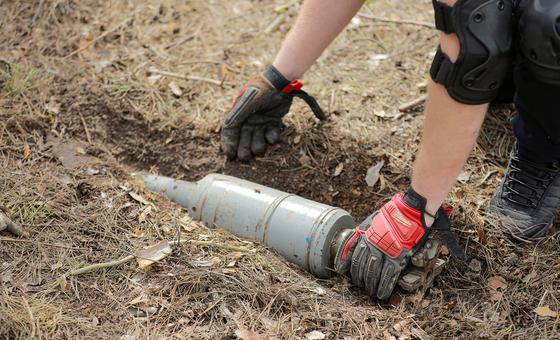
“It’s a double win when demining – which is always a good thing – is linked to sustainable agriculture and energy security, even when a conflict is ongoing,” according to Chris Loughran and Camille Wallen.Since Russia’s full-scale invasion of Ukraine in February 2022, the nation has become one of the world’s most heavily mined places with an estimated 25 per cent of the country contaminated with mines – an area four times the size of Switzerland.The report, titled Enhancing Mine Action Finance in Ukraine, explores novel financing solutions aimed at advancing Ukraine’s national mine action strategy to solve the massive demining challenge faced by the nation.Commissioned by UNDP at the request of Ukraine’s economic ministry, it scopes specific models that could reasonably be taken forward for potential application.Everything prior was ‘dress rehearsal’Since the First and Second World Wars, the Ukrainian Government has been managing risks associated with unexploded ordnance, but the current full-scale war is a whole new level of complexity, according to UNDP.Typically, 30 to 50 per cent of unexploded ordnance fails to detonate, but the rest remain active, with any physical impact potentially provoking an explosion, Alexander Lobov, a mine action expert with UNDP, said in an interview with UN News last year.This makes the sheer size of the invasion in Ukraine particularly dangerous and demanding, with a frontline of well over a thousand kilometers according to Paul Heslop, Chief Technical Advisor for the UNDP Mine Action Programme in Ukraine.In another interview earlier this year with UN News, Mr. Heslop, who has spent thirty years clearing mines in hotspots ranging from Mozambique to Afghanistan, described all those experiences as a “dress rehearsal” for Ukraine – his current and most challenging mission yet.
Two key solutionsThere are two key solutions to Ukraine’s demining challenge according to UNDP’s report.The first, known as a Sustainability-Linked Bond (SLB), seeks to synergise mine action efforts with Ukraine’s transition to sustainable agriculture, particularly through organic winter wheat production and “no till” farming practices.Meanwhile, Outcome-Based Public-Private Partnership (OB-PPP) would integrate mine clearance with solar energy development.By leveraging private sector involvement, the proposed SLB and OB-PPP models aim to meet Ukraine’s strategic needs in mine action, energy and agriculture, while also fostering economic recovery.Long-term commitment“UNDP is committed to fostering innovative solutions that address immediate needs while advancing Ukraine’s long-term sustainability goals,” said Jaco Cilliers, UNDP Resident Representative in Ukraine.“By aligning mine action with sustainable agricultural practices and renewable energy, we can help drive economic recovery and resilience in Ukraine,” he added.As Ukraine navigates the complexities of recovery and development, these innovative financing approaches represent a significant step towards a safer and more sustainable future.

